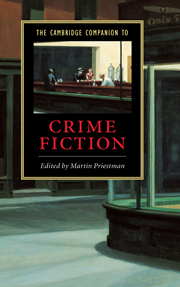Book contents
- Frontmatter
- Introduction
- 1 Eighteenth-century crime writing
- 2 The Newgate novel and sensation fiction, 1830-1868
- 3 The short story from Poe to Chesterton
- 4 French crime fiction
- 5 The golden age
- 6 The private eye
- 7 Spy fiction
- 8 The thriller
- 9 Post-war American police fiction
- 10 Post-war British crime fiction
- 11 Women detectives
- 12 Black crime fiction
- 13 Crime in film and on TV
- 14 Detection and literary fiction
- Guide to reading
- Index
- Series List
5 - The golden age
Published online by Cambridge University Press: 28 May 2006
- Frontmatter
- Introduction
- 1 Eighteenth-century crime writing
- 2 The Newgate novel and sensation fiction, 1830-1868
- 3 The short story from Poe to Chesterton
- 4 French crime fiction
- 5 The golden age
- 6 The private eye
- 7 Spy fiction
- 8 The thriller
- 9 Post-war American police fiction
- 10 Post-war British crime fiction
- 11 Women detectives
- 12 Black crime fiction
- 13 Crime in film and on TV
- 14 Detection and literary fiction
- Guide to reading
- Index
- Series List
Summary
The golden age of crime fiction is usually taken as the period between the two world wars, though some start it earlier, with the publication of E. C. Bentley's Trent's Last Case in 1913, and the first critic to use the term dated it from 1918 to 1930, followed by 'the Moderns'; major texts in 'golden age' style were also produced after 1940, both by new writers and by figures from the earlier period. The term 'golden age' has been criticised as being unduly homogenous and seen as inappropriately 'replete with romantic associations': in fact the types of crime fiction produced in this period were far from uniform - the psychothriller and the procedural began, there was a wide range of practice in the mystery and the stories do regularly represent types of social and personal unease which would contradict a notion of an idyllic 'golden' period.
However, while recognising variety in the period, as well as the relative uncertainty of its borders, it is still possible to identify a coherent set of practices which were shared, to a greater or lesser extent, by most of the writers then at work. Elements that were randomly present in earlier crime fiction suddenly become a norm, like multiple suspects, and some earlier tendencies largely disappear, notably the use of coincidence and historical explanations. A genre of crime fiction, best named for its central mechanism as the clue-puzzle and epitomised by Agatha Christie and ‘S. S. Van Dine’, clearly forms a recognisable entity by the mid-1920s.
- Type
- Chapter
- Information
- The Cambridge Companion to Crime Fiction , pp. 77 - 94Publisher: Cambridge University PressPrint publication year: 2003
- 12
- Cited by



